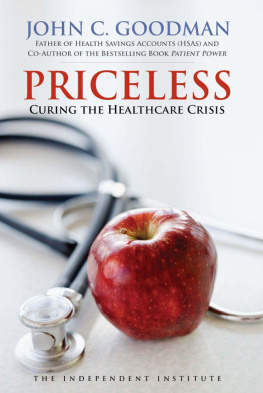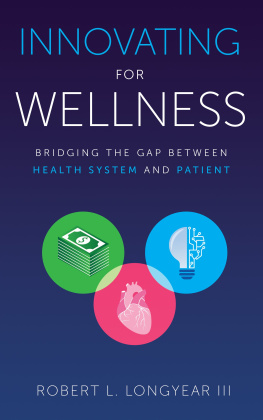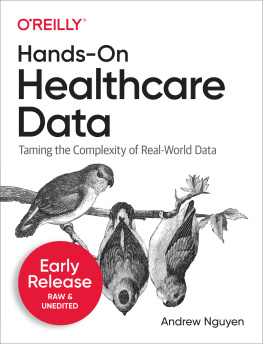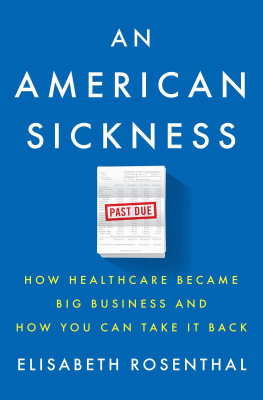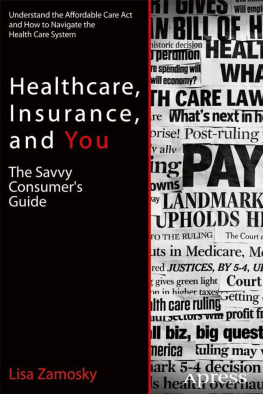JOHN C. GOODMAN
PRICELESS
CURING THE HEALTHCARE CRISIS

Priceless Copyright 2012 by The Independent Institute
All Rights Reserved. No part of this book may be reproduced or transmitted in any form by electronic or mechanical means now known or to be invented, including photocopying, recording, or information storage and retrieval systems, without permission in writing from the publisher, except by a reviewer who may quote brief passages in a review. Nothing herein should be construed as necessarily reflecting the views of the Institute or as an attempt to aid or hinder the passage of any bill before Congress.
The Independent Institute 100 Swan Way, Oakland, CA 94621-1428
Telephone: 510-632-1366 Fax: 510-568-6040 Email:
Website: www.independent.org
Cover Design: Keith Criss
Cover Image: Jamie Grill/Getty
Interior Design and Composition by Leigh McLellan Design
Library of Congress Cataloging-in-Publication Data
Goodman, John C.
Priceless : curing our healthcare crisis / John C. Goodman.
p. cm.
ISBN 978-1-59813-083-6 (hardcover : alk. paper)
1. Medical careUnited States. 2. Medical policyUnited States. 3. Medical care, Cost ofUnited States. 4. Health care reformUnited States. I. Title.
RA395.A3G657 2012
362.10973dc23
2012008379
16 15 14 13 12 5 4 3 2 1
| Preface |
| An Intellectual Odyssey |
WHEN GERALD MUSGRAVE and I wrote Patient Power two decades ago, we had no idea we were starting a revolution in thinking about health policy. At the time, just about everybody in the field was advocating managed care and managed competition. And I really mean everybody. The large insurance companies, the employer trade groups, the medical organizations, even the American Medical Associationall were in support of the prevailing ideas.
Aside from the libertarian Cato Institute (which published Patient Power), the conservative think tanks were just as enthusiastically advocating conventional thinking as the liberal ones. Conservative Republicans were as much on board as liberal Democrats. Historians will record that Hillary Clinton's healthcare reform plan went down to inglorious defeat. What they probably will neglect to say is that a very similar proposal had the support of most Senate Republicans at the time.
The Clinton health reform failed because of White House ineptitude and grass roots resistance. It did not fail because of any major disagreement between the two political parties about health policy.
It was a lonely time. At least for me.
When I took the idea of Health Savings Accounts (HSAs) to Capitol Hill in the early 1990s, only five members of Congress agreed to sign onto a bill creating them. When The Independent Institute published an important book on health policy a few years later, American Health Care, they could find only one economist on a university campus anywhere in America who would defend the idea of patients managing their own healthcare dollars.
In retrospect, what we said was not all that radical. Or even all that insightful. What mattered was that we dared to say it. We were like the child who declares that the emperor has no clothes. What we were saying was what thousands of others thought all along, but didn't quite know how to express.
Our book began an intellectual sea change in thinking about health policy. Even today, I meet people who tell me that their entire approach to health policy was shaped and molded by Patient Power.
So why do we need a new book? In part because the policy landscape has changed. In the not-so-distant future we may be living with the Affordable Care Act (ACA). In addition, there are four important things I have learned since I wrote Patient Power.
First is the importance of liberating doctors. Our focus in Patient Power was on freeing the patient. A good part of the book was devoted to the idea that when people are spending their own money they behave very differently than when they are spending other people's money. Give patients control over their own healthcare dollars, we argued, and they will become more careful, prudent consumers of medical care.
All that was true. What I didn't anticipate was that the changes on the supply side of the market would be far more profound than the changes on the demand side. On the consumer side of the market, patients spending their own money will shop, compare prices and decide to buy or not to buy. When you stop to think about it, there's not much more they can do. On the provider side, however, we are unleashing a torrent of entrepreneurial activity that would have been unthinkable only a decade ago.
When patients aren't spending their own money, there is no way doctors can compete for their patronage based on price. When they don't compete on price, they don't compete on quality either. The services they offer will be only those services the third parties pay for and only in settings and ways the third parties have blessed. But give patients control over their own healthcare dollars and the provider community will begin to meet needs in ways the third-party-payer bureaucracies could never have dreamed of. Who do you think is going to be more creative about meeting unmet needs? Executives at a handful of insurance companies? Or 800,000 doctors dealing with real patients day in and day out?
At one point, I was tempted to title this book, Doctor Power. Its central message could not be more radically different than the prevailing thinking in the health policy community. The orthodox view is that doctors are the problem. They have too much freedom, we are told. They need to be constrained and told what to do. But the orthodox view is wrong. Doctors are not the problem. They are the solution.
Have you ever heard the phrase, We are paying for volume, not value? If not, just attend a few more health conferences and you surely will. The problem with that point of view is that it suggests that we can make things right by changing the way buyers pay for care. Wrong. What we need is a system in which the provider side of the market competes to provide value because it is in their self-interest to attract patients in that way. We will never solve America's healthcare crisis from the buyer side of the market. It can only be solved from the provider side.
Over and over again I have discovered that every center of excellence, every example of exemplary care, every example of high-quality, low-cost medicine originated on the supply sidenot the demand sideof the market.
The second thing I missed the last time around was the importance of prices. The single worst public policy decision in all of heath care was the decision to eliminate money prices from the market for medical care. Have you ever wondered why the panhandler on the street corner has a cell phone, but no access to primary care? It's because he can buy a cell phone in a real marketplace, but he can't buy healthcare that way.
As this book goes to press, a new study finds that enrolling children in the Children's Health Insurance Program (CHIP: essentially, Medicaid for children) does not result in their receiving more medical care. But when CHIP pays higher fees to doctors, the children do get more care. Think about that for a minute. We encourage low-income families to enroll their children, usually by making the insurance absolutely free. Many of them drop their private coverage to take advantage of the offer. But we make it illegal for the family to add to CHIP's fees and pay the market rate for their care. They can have free health insurance only if they agree not to purchase the same care everyone else is able to buy.

